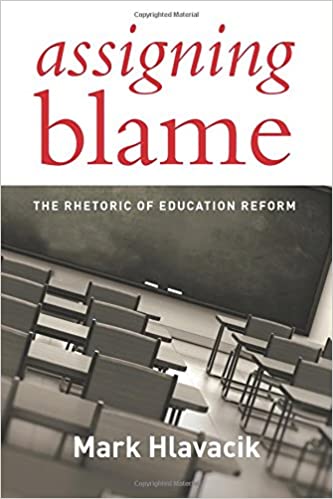Book Review: Hlavacik’s Assigning Blame: The Rhetoric of Education Reform
Hlavacik, Mark. Assigning Blame: The Rhetoric of Education Reform. Harvard Education Press, 2016.

Mark Hlavacik’s Assigning Blame: The Rhetoric of Education Reform is an in-depth analysis of conversations of and about the public school system in America, done through recounting advocacy acts and reforms that have impacted the system. By revealing major historical management issues involving the government and school administrators, it traces the evolution of the American educational system, and gives an account of its political and social actors, including strategies they employ. Hlavacik’s work interrogates the rhetoric of blame, which sadly has been the core of educational policy in the United States. Throughout this book, readers learn about old wounds and enduring obstacles within the American educational system, such as the education divide and segregation, that have prevented the system from being progressive or even practical. By following the author’s assessments of advocacy acts and policymakers, the real issue, we learn, is not the lack of reforms but rather too many useless reforms. Notably, Hlavacik purports that the shifting of blame for the failure of each education reform or policy between 1980 and 2015 reveals the destructive power of this rhetorical strategy that is common to each of the cases analyzed in his book.
The US education system has witnessed dramatic changes between 1980 and 2015 in terms of reforms and policies meant to democratize the discourse and practice of public schools in the country. Hlavacik’s book in five case studies closely examines some of the main issues that have influenced and contributed to education reforms in America. The leitmotif running through the five public acts is blame or psogos, an old rhetorical strategy that has proven reliable in different spheres of engagement, especially in the domain of politics, while also gaining intellectual interest among scholars. Hlavacik’s account reveals that whenever social actors have identified weaknesses within the public education system, these advocates and policymakers resort to blame as a means of persuasion. Thus, blame has come to define the rhetoric of education reform, though apart from blame, other strategies employed by blamers in Hlavacik’s book are metaphor, scapegoating, and confession.
The first act analyzed by Hlavacik is Milton Friedman’s 1980 show, Free to Choose. Friedman is presented as thoughtfully employing blame in his show, in which he portrays bureaucrats as inconsiderate of public interest while pitching parents as lacking agency. Parents and students were at the mercy of bureaucrats and educators, in Friedman’s estimation. Relying on ad hominem, the University of Chicago economist demonstrates his knowledge of educational policy in dealing with his opposition—bureaucrats—before the American audience, making him as persuasive as he could be, Hlavacik argues.
Hlavacik walks readers through the ten episodes of Free to Choose, indicating how Friedman’s debating technique incapacitated educators not because his deliberation was coherent but because of his antibureaucrat rhetoric that left out important details that might have made his arguments less convincing.
In his second case study, about a 1983 report by the National Commission on Excellence in Education (NCEE), A Nation at Risk: The Imperative for Educational Reform, Hlavacik notes that the style of blame is slightly different from Friedman. A Nation at Risk employed self-blame, thus propelling Americans to act by demanding better education policies that would ultimately lead to economic prosperity for the people. Centering on the dangers of negligence in the discourse of public education, the report argues that US public schools were not yet a lost cause, and redeemable only through formidable action. The NCEE’s report style, Hlavacik claims, contributed to its persuasive powers employing logos; rich usage of statistics and quotes, making it easily accessible to readers.
Hlavacik suggests the NCEE’s report was a critical assessment of US education policy but the critique was portrayed as objective, considered a critical evaluation done out of absolute necessity. This sort of objection seems unnecessary and reveals the author’s reservation about the report. Ultimately, Hlavacik agrees that NCEE was quite influential on education policies in the 1990s and 2000s, acclaimed for resolving some of the longstanding issues of social class equality in American education. The achievement era was indeed a turning point for US public school systems because not only was the report effective in revealing the deteriorating quality of education from the 1980’s, but it also encouraged accountability. Thus, Americans had to accept blame for the part they played in the failing system, but it also spurred them to raise their standards and expectations. This conclusion stamps the act as a monologue, thus suggesting that its perspectives lack diversity. The NCEE’s act may thus be considered as inaccessible to dialogues from a diversity of audience, going by Hlavacik’s analysis.
Next, we are introduced to Jonathan Kozol’s 1991 Savage Inequalities, which illuminated the shabby treatment of pupils who attended segregated schools and advocated for desegregation of public schools across America. Hlavacik delves into Savage Inequalities, pinpointing what he considers a double-edged sword—Kozol’s dependence on geographic metaphors and relating his experience of his case studies in third-world terms. Hlavacik argues that Kozol’s heavy use of metaphor was a mere digression for readers. He soon reveals that the response to Kozol’s advocacy was simplified to a funding problem, just as Western countries provide aid for developing countries, which tends to leave them worse off. Through Hlavacik’s recounting of Kozol’s work, readers learn that public school systems often mirror the reality of their city.
In one breath, Hlavacik praises Kozol’s brilliant imagery and detailed account of horrors that students in poor, urban schools encounter. Still, Hlavacik believes Kozol’s audience was moved by the book’s disturbing details to resist integration of America’s public schools. Hlavacik insists that Savage Inequalities is a failure, not persuasive enough to result in the reform Kozol hoped for. Hlavacik blames this on the vagueness and disconnect Americans might have perceived when confronted with unfamiliar locations such as East St. Louis, San Antonio, and some parts of Chicago and New York which were portrayed as third-world zones. In addition, Hlavacik attacks Kozol’s ethnographic account for imposing a lack of hope over these geographically segregated poor cities, portrayed as lost causes.
Hlavacik submits that perhaps had Kozol clearly advocated for a desegregation policy, his work might have been received differently. He is also of the view that Kozol’s proposal for integration seemed impractical, especially in the isolated geographies he focused on, because it was based on the unpalatable experiences of the inhabitants of such spaces.
The most controversial act Hlavacik evaluated no doubt is George W. Bush’s No Child Left Behind (NCLB) Act of 2001. Hlavacik carefully takes a position about the policy by emphasizing that his concern was not to condemn or praise NCLB, but it was such an important law that was purely concerned with enforcing accountability to the detriment of students’ performance. Readers learn that scapegoating was particularly unique to NCLB. Students’ test scores were the main yardstick of achievement, and the burden of students’ performance fell on school administrators and teachers. Hlavacik stresses that the federal government’s act of scapegoating administrators and teachers sent a clear message to dissociate NCLB from the shameful act of low-test score performance. Furthermore, blaming became a ritual throughout NCLB’s time, which resulted in a division between successful schools and failing schools. At the state level, rituals of accountability were created to separate performing schools from those failing, such that the yardstick of measuring progress perfectly matched that of the federal government.
A major issue with NCLB was that local schools and educators were disillusioned, made to believe they were more powerful than they were, and thus unable to come to terms with their inability to improve their schools and students. No doubt they had the authority in decision making but they lacked agency in that they bore the responsibility of failure. The Adequate Yearly Progress (AYP) was used to judge schools that were meeting the federal government’s standards. Hlavacik’s thought-provoking question “Was the spirit of NCLB to punish or repair schools that failed to make AYP?” seems quite straightforward as the law clearly omitted several factors that might be responsible for non-performance in schools. Readers can clearly see that school administrators and teachers at the local level were in a fix with NCLB’s unrealistic expectations; thus, they willingly accepted being sacrificial scapegoats of a systemic problem. Readers are reminded that while NCLB provided corrective actions (at least in theory) for state and local administrators, ultimately that “corrective” came to mean punishment, because schools that went through this process ended up being transformed into charters. To wrap up this case study, Hlavacik reflects on legacies of the NCLB—the punishing or rewarding system that has come to mark public education in America, with, of course, educators at the receiving end.
Hlavacik’s last case study is Diane Ravitch’s public act of blame, which Hlavacik acknowledges was not very surprising considering how much havoc NCLB was causing in public schools. What surprised Americans, Hlavacik asserts, was that Ravitch had been an advocate for NCLB only to turn into a huge critic. The author unravels Ravitch’s conversion from a promoter of NCLB to an attacker, riding on the backs of former critics of the law. However, Ravitch’s credibility as an education policy intellectual made her stand out from the old critics of NCLB. Beyond her credibility, the kairos of her conversion was no doubt influential for the Every Student Succeeds Act of 2015. Hlavacik argues that Ravitch’s honesty in her book, The Death and Life of the Great American School System, and her Wall Street Journal op-ed were quite strategic because of how she positioned herself as having been swayed by the power of language NCLB employed.
Readers learn how Ravitch weaponized kairos to debunk NCLB’s promises as too good to be true. Connecting Ravitch’s clever use of blame and ethos to its outcome, Hlavacik suggests that Ravitch’s advocacy and push for a new reform was successful, citing that President Obama modeled his critique of NCLB after Ravitch’s, both highlighting the obsession over testing at the expense of quality education and the “deceptive use of language” employed in the law.
In the last two chapters of Assigning Blame, Hlavacik reflects on where blame has landed the public school system in America, then argues against the continuous deployment of blame while acknowledging that it had been a compelling tool in the past. Upon completing his evaluation of the five case studies, Hlavacik challenges America to move beyond the rhetoric of blaming. To achieve a better education system, he insists that a more inclusive and engaging structure, not one where people point fingers, is necessary. One alternative is praise.
Hlavacik’s work is useful and relevant not just for narrating history but for reflecting on past mistakes and re-strategizing towards an advanced and more equal educational system. Hlavacik presents sufficient evidence that blame has been overused such that it is negatively impacting civic participation toward a better US educational system. He thus challenges advocates of education reform to rethink their strategies. In short, the politicking of education is standing in the way of the American dream in the education sector.
Hlavacik’s hope is for inclusive engagement in education advocacy and reforms because education incorporates so many competing motivations. This book asks readers to consider this: if blame is forged for the sake of politics, should we realistically expect a different strategy in the politics of education or newer strategies combined with the old trusted one/s? At the end of the book one can see that the democratization President Jimmy Carter hoped for when the United States Department of Education was established has not been fully realized. Yet Hlavacik assures us that there is hope if Americans are ready to take the bull by the horns. The acts explored in Assigning Blame, whether successful or not, have shaped American education policy in the last four decades, thus, America can learn from its past.
KEYWORDS: education, rhetoric, blame, advocacy, educational policy




 Tolulope Odebunmi is a critical discourse analyst, a trained linguist, and a PhD candidate at Michigan Technological University. Specializing in sociolinguistics, her interests include politics, globalization issues, gender politics, and popular culture. She was a Fulbright Foreign Language Teaching Assistant at Michigan State University. She is currently a visiting scholar at Jean Jaurès University, Toulouse, France, where she teaches English communication.
Tolulope Odebunmi is a critical discourse analyst, a trained linguist, and a PhD candidate at Michigan Technological University. Specializing in sociolinguistics, her interests include politics, globalization issues, gender politics, and popular culture. She was a Fulbright Foreign Language Teaching Assistant at Michigan State University. She is currently a visiting scholar at Jean Jaurès University, Toulouse, France, where she teaches English communication.